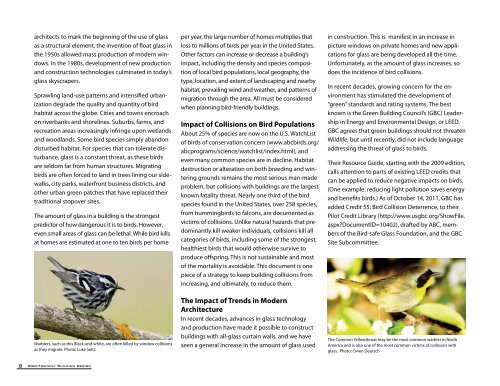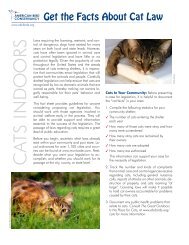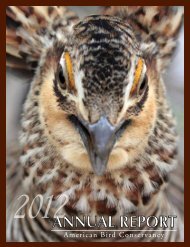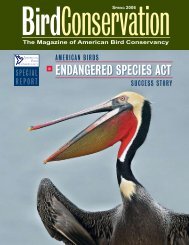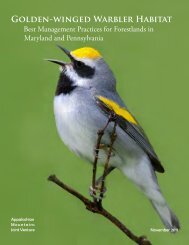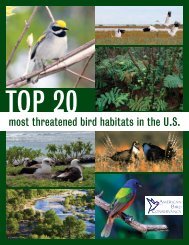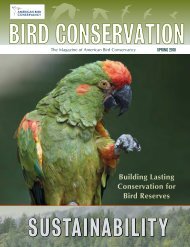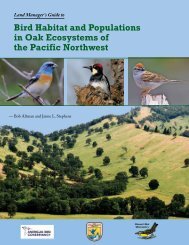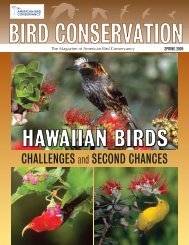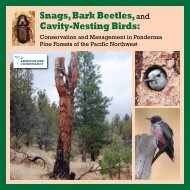Bird-Friendly Building Design Bird-Friendly Building Design
Bird-Friendly Building Design Bird-Friendly Building Design
Bird-Friendly Building Design Bird-Friendly Building Design
You also want an ePaper? Increase the reach of your titles
YUMPU automatically turns print PDFs into web optimized ePapers that Google loves.
architects to mark the beginning of the use of glassas a structural element, the invention of float glass inthe 1950s allowed mass production of modern windows.In the 1980s, development of new productionand construction technologies culminated in today’sglass skyscrapers.Sprawling land-use patterns and intensified urbanizationdegrade the quality and quantity of birdhabitat across the globe. Cities and towns encroachon riverbanks and shorelines. Suburbs, farms, andrecreation areas increasingly infringe upon wetlandsand woodlands. Some bird species simply abandondisturbed habitat. For species that can tolerate disturbance,glass is a constant threat, as these birdsare seldom far from human structures. Migratingbirds are often forced to land in trees lining our sidewalks,city parks, waterfront business districts, andother urban green patches that have replaced theirtraditional stopover sites.The amount of glass in a building is the strongestpredictor of how dangerous it is to birds. However,even small areas of glass can be lethal. While bird killsat homes are estimated at one to ten birds per homeper year, the large number of homes multiplies thatloss to millions of birds per year in the United States.Other factors can increase or decrease a building’simpact, including the density and species compositionof local bird populations, local geography, thetype, location, and extent of landscaping and nearbyhabitat, prevailing wind and weather, and patterns ofmigration through the area. All must be consideredwhen planning bird-friendly buildings.Impact of Collisions on <strong>Bird</strong> PopulationsAbout 25% of species are now on the U.S. WatchListof birds of conservation concern (www.abcbirds.org/abcprograms/science/watchlist/index.html), andeven many common species are in decline. Habitatdestruction or alteration on both breeding and winteringgrounds remains the most serious man-madeproblem, but collisions with buildings are the largestknown fatality threat. Nearly one third of the birdspecies found in the United States, over 258 species,from hummingbirds to falcons, are documented asvictims of collisions. Unlike natural hazards that predominantlykill weaker individuals, collisions kill allcategories of birds, including some of the strongest,healthiest birds that would otherwise survive toproduce offspring. This is not sustainable and mostof the mortality is avoidable. This document is onepiece of a strategy to keep building collisions fromincreasing, and ultimately, to reduce them.in construction. This is manifest in an increase inpicture windows on private homes and new applicationsfor glass are being developed all the time.Unfortunately, as the amount of glass increases, sodoes the incidence of bird collisions.In recent decades, growing concern for the environmenthas stimulated the development of“green” standards and rating systems. The bestknown is the Green <strong>Building</strong> Council’s (GBC) Leadershipin Energy and Environmental <strong>Design</strong>, or LEED.GBC agrees that green buildings should not threatenWildlife, but until recently, did not include languageaddressing the threat of glass to birds.Their Resource Guide, starting with the 2009 edition,calls attention to parts of existing LEED credits thatcan be applied to reduce negative impacts on birds.(One example: reducing light pollution saves energyand benefits birds.) As of October 14, 2011, GBC hasadded Credit 55: <strong>Bird</strong> Collision Deterrence, to theirPilot Credit Library (http://www.usgbc.org/ShowFile.aspx?DocumentID=10402), drafted by ABC, membersof the <strong>Bird</strong>-safe Glass Foundation, and the GBCSite Subcommittee.Warblers, such as this Black-and-white, are often killed by window collisionsas they migrate. Photo: Luke SeitzThe Impact of Trends in ModernArchitectureIn recent decades, advances in glass technologyand production have made it possible to constructbuildings with all-glass curtain walls, and we haveseen a general increase in the amount of glass usedThe Common Yellowthroat may be the most common warbler in NorthAmerica and is also one of the most common victims of collisions withglass. Photo: Owen Deutsch8 <strong>Bird</strong>-<strong>Friendly</strong> <strong>Building</strong> <strong>Design</strong>


